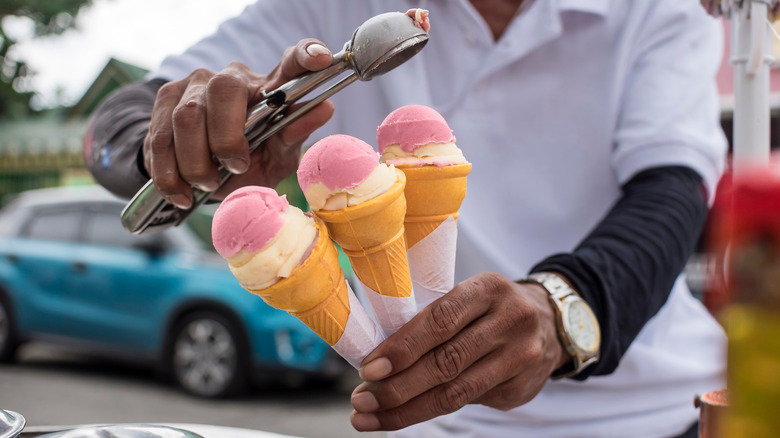How Filipino Dirty Ice Cream Got Its Mischievous Name
There may be nothing human beings love more than creamy, frozen treats, as evidenced by the fact that it existed well before modern refrigeration. As early as 200 B.C., the Chinese were making proto-ice cream using snow. Explorers and tradespeople brought knowledge of this cold, creamy wonder back to their homelands, eventually leading to the invention of Italian gelato, Indian kulfi, Mexican paletas, and Filipino-style sorbetes — colloquially known as "dirty ice cream."
This cheeky nickname has little to do with the quality of the ice cream, but rather the original perception of it. Sorbeteros have been selling a variety of sorbetes flavors from colorful wooden carts for decades — a sight Filipino children quickly began to associate with cold, tasty desserts. Their mothers, however, were wary of ice cream being sold in the streets and dissuaded their children from asking for it by calling it "dirty ice cream." Of course, these efforts were largely unsuccessful (as anyone who's ever interacted with children could predict) and sorbeteros quickly became a staple of Filipino street cuisine.
Today, the term "dirty ice cream" is used colloquially by Philippines natives and tourists alike to describe this unique treat. The term is no longer a criticism of ice cream sold in the streets, but an affectionate name for something nostalgic to many. Just as American children flock to the sidewalks when they hear the cheerful ditties played by local ice cream trucks, Filipino children are always listening for the ring of the sorbeteros' bells.
Sorbetes vs. American ice cream
At first glance, Filipino and American-style ice creams are fairly similar. Before electric ice cream makers were widely available, Americans used manual churns featuring a lidded metal canister with a hand-cranked paddle to blend the ice cream. The canister was placed in a wooden bucket filled with salt and ice to freeze the custard into ice cream as it mixed. Filipinos used a nearly identical mechanism called a garapiñera to make sorbetes. Both manual machines produced a rich, creamy frozen custard.
However, this is where most of the similarities end. Filipinos had less access to cow's milk, so sorbetes are usually made with water buffalo milk or — more often — coconut milk. Additionally, some of the most popular flavors would be considered unusual to the typical American palate. Though chocolate, strawberry, and cookies 'n cream are common, mango, avocado, ube (purple yam), and cheese — sharp cheddar cheese to be exact — are also standard Filipino flavors. We have to admit the combo of sugary cream and salty, earthy cheddar sounds intriguing.
Another difference is in the way sorbetes is served. Before waffle cones were invented, ice cream vendors had to be creative with the vessels they used. In the States, paper and thin cookie wafers were common. In the Philippines, the solution was to dollop two scoops of sorbetes in fluffy bread buns. Sugar cones are just as common today, but most sorbeteros still offer bread buns as a traditional portable and edible vessel for this not-so-dirty delight.

